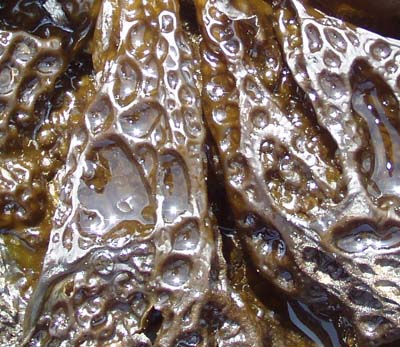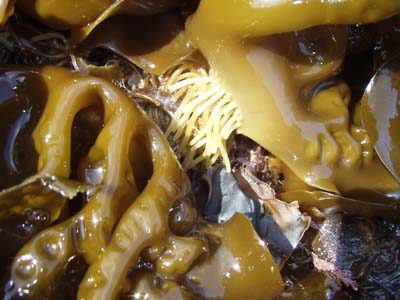
Morphology
A bullate, pocketed blade from a sheltered location (Mar Vista)
The haptera connected directly to blade margin
Typical U-shaped smooth blade margin
The conformed holdfast of a plant removed from the rock |
The sea cabbage is also known as the 'stipeless kelp' because the holdfast, or haptera, is connected directly to the thickened lower margin of the blade and there is no stipe present. It can grow to 150 cm (5 feet) in length and 80 cm (32 inches) wide (5), but it is more commonly 30-60 cm (1-2 ft) across in the San Juan Islands. There is much variation in morphology among individuals from a broad, ruffled or bullate blade to a smooth and deeply divided blade:
The intercalary meristem is near the base of the blade (6) and the thallus consists of one large blade with inrolling at the basal margins (8) and has a thickened, smooth area at the base usually looping into a U- shape and the holdfasts conform to rock contours. Like all Laminariales, a cross-section of S. sessile reveals the elongated cells of the inner medulla surrounded by the large round cortex cells and an outer epidermis, usually covered in mucus (8).
A cross-section through a blade showing the tissue layers (1 mm wide) |
(5) O’Clair, Rita and Sandra C. Lindstrom. North Pacific Seaweeds. Plant Press. Auke Bay, AK: 2000.
(6) Armstrong, S.L. 1989. The behavior in flow of the morphologically variable seaweed Hedophyllum sessile (CAG) Setchell. Hydrobiologia, 183, 115-122.
(7)Armstrong, S. L. (1982) Mechanical Behavior of 2 morphs of Hedophyllum Sessile (Phaeophyta, Laminariales) from exposed and protected habitats. American Zoologist, 22, 907-907.
(8) Lee, Robert Edward. Phycology. Cambridge University Press, 1999.




